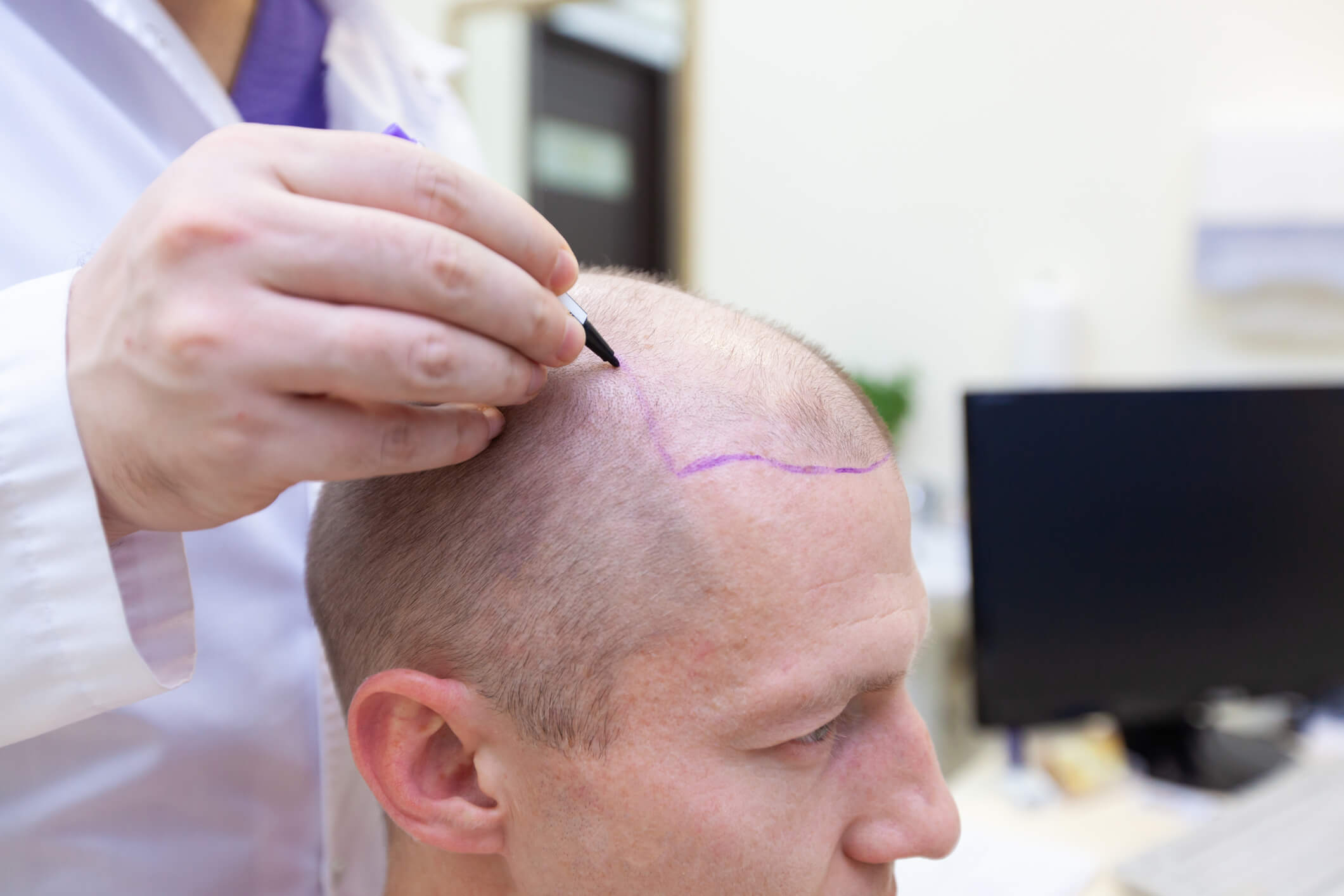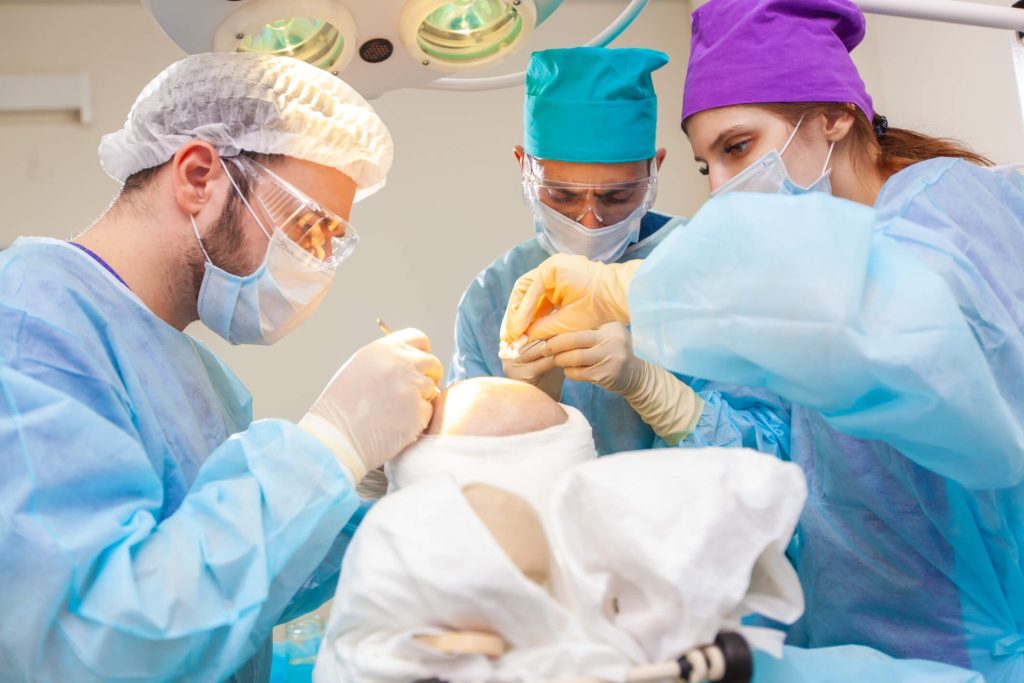Hair loss is a prevalent issue that frequently results in a decline in self-esteem and confidence, affecting both men and women. Consequently, numerous individuals investigate hair restoration alternatives, such as hair transplant procedures, to regain and reestablish their well-being. However, with abundant treatments available, the question remains: Is hair restoration worthwhile?
This blog article will explore the efficacy, success rate, and costs of hair restoration surgery, including hair grafts, to assist you in determining whether it is the appropriate course of action for you. Additionally, we will discuss important considerations, such as medication options and the role of a reputable hair transplant clinic, to ensure you make an informed decision. With various treatments and costs to consider, understanding the potential benefits and outcomes of hair restoration can help you decide if it aligns with your goals.
What is Hair Restoration?
Hair restoration encompasses diverse procedures intended to address hair loss and stimulate hair regrowth. The most frequently selected alternatives are as follows:
- Hair Transplant Surgery: This procedure involves transplanting hair follicles from a donor area (typically the back of the head) to areas with diminishing or no hair.
- PRP Therapy: A non-surgical procedure that involves collecting, processing, and injecting blood into the skull to promote hair growth.
- Topical Treatments: Medications such as finasteride and minoxidil facilitate hair regrowth and slow hair loss.
- Laser Therapy: Low-level laser devices enhance hair density and stimulate hair follicles.
Effectiveness of Hair Restoration
The efficacy of hair restoration depends on the individual’s hair loss pattern, the stage of hair loss, and the treatment selected.
- Hair Transplant Surgery: Hair Transplant Surgery is one of the most effective options, particularly for individuals with severe male-pattern baldness or diminishing hair in specific regions. The outcomes are irreversible; however, observing the complete picture may take several months.
- PRP Therapy: For individuals experiencing early phases of hair loss, PRP may be effective in promoting hair growth. Nevertheless, the outcome may differ, and multiple sessions may be necessary.
- Topical therapies: In certain instances, these may facilitate hair regrowth and mitigate hair loss. Nevertheless, the benefits may be limited, necessitating ongoing use.
- Laser therapy: Although specific studies have demonstrated that laser therapy can enhance hair density, the results are generally modest and may require significant improvements to observe.
Price of Hair Restoration
The expense of hair restoration is extensively contingent upon the treatment method and the procedure’s scope. The following is a breakdown of prospective hair transplant costs:
- Hair Transplant Surgery: is frequently the most costly alternative, with costs ranging from $4,000 to $15,000, contingent upon the clinic’s location and the number of grafts required.
- PRP therapy: The cost of a single session of PRP therapy typically ranges from $1,500 to $3,500. Optimal outcomes may necessitate multiple sessions.
- Topical Treatments: Minoxidil, an over-the-counter product, costs approximately $20 to $60 monthly, making it a more cost-effective alternative for many individuals.
- Laser Therapy: Professional treatments can cost $500 to $1,500 per session, while at-home devices can cost $200 to $1,000.
Although hair restoration can be expensive, numerous individuals consider it a beneficial investment because of its long-term advantages.
Advantages of Hair Restoration
- Enhanced Appearance: One of the most substantial advantages of hair restoration is enhancing one’s appearance. Dense and full hair can help one appear more confident and youthful.
- Enhanced Self-Assurance: Hair loss can result in feelings of insecurity and self-consciousness for many individuals. Restoring hair can significantly affect significantly affect one’s mental health and self-assurance.
- Permanent Results: Surgical hair restoration, including hair transplants, provides long-term results. The hair follicles continue to develop naturally after being transplanted, offering a permanent solution to hair loss.
- Noninvasive Alternatives: PRP therapy, topical medications, and laser therapy provide effective alternatives for individuals who prefer non-surgical treatments with minimal interruption.
Potential Drawbacks
Although hair restoration can be highly advantageous, there are a few potential disadvantages to take into account:
- Cost: As previously mentioned, hair restoration procedures can be costly, particularly those that involve surgery.
- Duration: The results of non-surgical interventions such as PRP and laser therapy necessitate multiple sessions over several months.
- Not a Universal Solution Resolution: Not all individuals are suitable candidates for hair restoration. It is imperative to seek the advice of a specialist to ascertain the most suitable treatment for your unique requirements.
Recovery Time and Post-Procedure Care
The optimal outcomes of a hair restoration treatment necessitate recovery time and post-procedure maintenance. What you can anticipate is as follows: Following the hair transplant procedure, patients will need to follow specific methods for care to minimize scarring and ensure the best results. Clinics may recommend medications like Propecia or Rogaine as part of the post-treatment regimen to help maintain hair growth. Surgeons will provide detailed information on recovery expectations, including the potential cause of hair shedding during the healing process. While the recovery process can vary, everyone must consider the time it takes for the transplanted hair to grow and the importance of following aftercare instructions. By understanding these factors, patients can achieve the best possible outcome and minimize any potential risks associated with the procedure.
Time Required for Recovery
- Hair Transplant Surgery: Most individuals experience moderate swelling and discomfort for a few days. Hair growth is typically observed after 3–6 months; a complete recovery typically takes 7–10 days.
- PRP Therapy: Minimum interruption is associated with platelet-rich plasma (PRP) therapy. Within 24–48 hours, most individuals can resume their regular activities.
- Laser Therapy and Topical Treatments: Noninvasive treatments that require minimal to no recovery time and produce progressively improving results.
Postoperative Care
- Hair Transplant Surgery: For a few weeks, adhere to your surgeon’s instructions, avoid direct sun exposure, and refrain from strenuous activities.
- PRP Therapy: For a few days, keep the scalp clean and refrain from handling or massaging it.
- Laser Therapy and Topical Treatments: To achieve the best possible outcomes, it is essential to maintain a consistent treatment regimen and refrain from skipping sessions.
To achieve the desired result from your hair restoration procedure, it is essential to exercise patience and provide proper treatment.
Alternatives to Hair Restoration
Several alternatives exist if you’re considering options other than hair restoration treatments. These options may not offer permanent results like hair restoration, such as Neograft Hair Restoration Orange County, but can help manage hair loss or improve the appearance of thinning hair. It’s essential to consider the treatments available and the potential causes of hair loss, such as injury or skin conditions. While shampoos or topical treatments may offer temporary relief, they may not address the underlying issue. Additionally, anyone considering a hair transplant procedure should be aware of potential scars and pain associated with the graft process. Be sure to consult with a professional to get recovery tips and understand the hair transplant cost, ensuring you make an informed decision for your body and hair health.
Wigs and Hairpieces
- Description: Wigs and hairpieces are non-surgical solutions that cover thinning or balding areas. They come in various styles, lengths, and colors.
- Effectiveness: Provides an immediate and customizable solution for hair reduction.
- Cost: $100 – $3,000, depending on the quality and style.
- Pros: Instant results, variety of styles, no need for medical procedures.
- Cons: Requires maintenance, can feel uncomfortable, and may need replacement over time.
Hair Fibers
- Description: Hair fibers are minute, pigmented fibers that cling to natural hair, resulting in a more voluminous and dense appearance.
- Effectiveness: Provides a temporary solution to cover thinning areas.
- Cost: $20 – $50 per bottle.
- Pros: Quick, affordable, easy to apply, and provides instant volume.
- Cons: Temporary, which may not work for severe hair loss or can be messy.
Scalp Micropigmentation
- Description: This method entails placing minute dots on the scalp to simulate the appearance of hair follicles, thereby generating the appearance of a fuller crop of hair.
- Effectiveness: It can provide a realistic look for people with thinning hair or bald spots.
- Cost: $1,500 – $4,000.
- Pros: Noninvasive, immediate results, low maintenance.
- Cons: It is not suitable for people with extensive hair loss; the results are permanent but can fade over time.
Healthy Lifestyle Changes
- Description: Preventing additional balding and fostering healthier hair growth can be achieved by adhering to a nutritious diet, managing stress, and refraining from using abrasive hair treatments.
- Effectiveness: It may slow down balding and improve hair health, but won’t necessarily reverse thinning.
- Cost: Free or low-cost, depending on lifestyle changes.
- Pros: Natural, no side effects, benefits overall health.
- Cons: Results are gradual and not guaranteed.
Hairstyles and Cuts
- Description: A well-chosen haircut or style can help conceal thinning areas and give the appearance of thicker hair.
- Effectiveness: A good haircut can make a significant difference to the way your hair looks.
- Cost: $20 – $100 per haircut.
- Pros: Instant results, affordable, no medical intervention required.
- Cons: Temporary, may not be effective for severe hair loss.
Factors Influencing the Decision
The appropriateness of hair restoration for an individual depends on various factors, including the condition of your hair and scalp, the amount of hair loss, and your overall health. These factors will assist you in evaluating the efficacy, cost, and long-term advantages of various treatments. Key considerations include:
- The type of hair transplant procedure.
- The potential for infection.
- The form of hair restoration is best suited to your needs.
Additionally, it’s essential to weigh the reasons for seeking treatment, your rights as a patient, and the expertise of the hair transplant clinic. By considering all these things, you can make an informed decision that aligns with your goals and life situation. Whether you’re looking to restore hair at the top or corners of your head, understanding the state of your hair and the procedure options will help guide your decision.
Extent of Hair Loss
- Description: The most suitable treatment option is contingent upon the severity and stage of your hair loss.
- Impact: Hair transplants may prove more advantageous in the event of substantial hair loss or hairless patches. Noninvasive remedies, such as topical or PRP therapy, may be adequate for early-stage hair loss.
Age
- Description: The expected results and treatment type can be influenced by age.
- Impact: Non-surgical treatments may benefit younger individuals, while elderly individuals with more advanced hair loss may wish to contemplate hair transplants for long-term outcomes.
Budget
- Description: Hair restoration treatments vary considerably, with more expensive surgical options.
- Impact: Your financial constraints will be critical in determining whether to pursue costly procedures such as hair transplants or more cost-effective alternatives such as PRP or topical therapy.
Expected Outcomes
- Description: Your decision regarding hair restoration will be determined by your expectations.
- Impact: A hair transplant may be optimal for individuals seeking permanent, natural-looking results. Hair fibers or wigs may be more appropriate for impermanent enhancements.
Recovery Time
- Description: The recovery period following treatment may differ, and specific individuals may favor a noninvasive, expedited solution.
- Impact: Hair transplants necessitate a prolonged recovery period (7-10 days), whereas treatments such as PRP therapy or laser therapy necessitate minimal delay, rendering them more appealing to individuals with demanding schedules.
Risk Tolerance
- Description: Certain treatments, particularly surgical ones, are associated with inherent hazards.
- Impact: Non-surgical alternatives, such as PRP therapy or topical treatments, may appeal more to risk-averse individuals due to their low risk of complications and complications.
Long-Term Commitment
- Description: While some hair restoration treatments necessitate ongoing maintenance, others provide permanent results.
- Impact: A hair transplant may be optimal for those who desire a permanent, long-term solution. Nevertheless, options such as PRP therapy or topical medications may suit you if you are prepared to commit to ongoing treatments.
Personal Preferences
- Description: Your decision will be influenced by your preferences, such as your comfort level with surgery or your willingness to use products regularly.
- Impact: While some individuals prefer the noninvasive and convenient nature of treatments such as PRP or laser therapy, others may prefer the more permanent hair transplant solution.
Conclusion
In the final analysis, the value of hair restoration depends on your objectives, financial constraints, and the type of hair loss you are experiencing, such as pattern hair loss or alopecia. Hair restoration can benefit those willing to invest time and money in a long-term solution, with options like follicular unit extraction (FUE) or follicular unit transplantation (FUT) performed by a skilled hair transplant surgeon. However, it’s essential to consider the risks and consult with your doctor to determine if you are a suitable candidate for these procedures. Non-surgical treatments, such as PRP therapy, laser therapy, or topical medications, may offer a more cost-effective and minimally invasive alternative for individuals in the early stages of hair thinning or those hesitant to undergo surgery. Research on hair loss treatments continues to evolve, providing more options for those looking to address their hair concerns effectively.
Frequently Asked Questions
Is it possible for hair restoration to alleviate hair loss in women?
Indeed, hair restoration can be a viable solution for women and men experiencing hair loss. Depending on the cause and severity of hair depletion, women and men may find PRP therapy, hair transplants, and laser therapy advantageous. A consultation with a specialist will determine the most effective treatment plan to improve hair thickness.
Will my hair appear thicker promptly following the treatment?
Results necessitate time. A few weeks following a hair transplant, the transplanted hair will fall out, and new hair will begin to develop in approximately 3–6 months. Hair density and regrowth will gradually improve, with non-surgical interventions such as PRP or laser therapy showing effectiveness over several months.
Is it possible to restore a complete head of hair using hair restoration treatments?
In advanced cases of hair loss, hair restoration may not always entirely restore a full head of hair, even though it can restore significant hair density. The outcome is contingent upon the selected treatment and hair loss severity. Multiple treatments may be necessary in certain instances to accomplish the desired result.
How can I identify a trustworthy hair restoration specialist?
Researching a hair restoration specialist’s qualifications, experience, and patient evaluation before selecting them is crucial. Seek out a licensed practitioner or board-certified surgeon with expertise in hair restoration procedures. During a consultation, you can ask for inquiries, review before-and-after photos, and ascertain that you are comfortable with the professional.
Should I use a special shampoo after a hair restoration procedure?
Indeed, it is crucial to use a gentle, sulfate-free cleanser following a hair restoration procedure to prevent scalp irritation. Your specialist may suggest shampoo products to facilitate healing and safeguard the newly transplanted hair follicles during recovery.
What is the most effective method for maintaining the results of hair restoration?
Ongoing maintenance is frequently necessary to preserve results. For instance, topical treatments such as minoxidil may require daily application, whereas PRP therapy may require reapplication every 3–6 months. The results may be preserved by adhering to a healthy lifestyle that encompasses stress management and appropriate nutrition.
Is it possible to restore hair to alleviate receding hairlines?
Indeed, hair restoration treatments, particularly hair transplants and PRP therapy, can alleviate receding hairlines. A study has shown that PRP therapy can enhance density and stimulate hair growth, while a hair transplant can restore hairs to receding areas. These treatments offer a promising answer for those seeking to address hair loss effectively.
Can I resume my regular activities following hair restoration?
Normal activities can typically be resumed within a day or two with non-surgical treatments such as PRP and laser therapy. To guarantee proper healing and prevent complications, it is crucial to refrain from engaging in strenuous activities for approximately one week following a hair transplant.
Is the appearance of the results of hair restoration treatments natural?
Indeed, hair restoration treatments, particularly hair transplants, can yield remarkably realistic results when executed by a seasoned specialist. PRP therapy, a non-surgical treatment, can stimulate natural growth to achieve a broader appearance, and the transplanted hair seamlessly integrates with your natural hair.
What is the most effective method for selecting the appropriate hair restoration treatment?
The appropriate treatment depends on the severity of your hair loss, budget, desired results, and personal preferences. Non-surgical treatments, such as PRP or laser therapy, may be more appropriate for early-stage hair loss, while surgical options, such as hair transplants, provide permanent results. Consulting with a specialist can help determine the optimal course of action.
Are you Ready to Start Your Hair Transplantation Journey?
Observing hair thinning or a receding hairline can be disconcerting, particularly when it begins to impact one’s confidence. You are not alone in contemplating the value of hair restoration. Numerous individuals encounter this dilemma, who must balance the prospective advantages with the time, cost, and effort necessary. Hair restoration can be a transformative solution; however, it is crucial to comprehend the factors that contribute to an informed decision.
Hair restoration treatments, including hair transplants, PRP therapy, and topical remedies, have become increasingly popular because they can enhance the appearance of thinning or balding areas and restore hair growth. These treatments can provide substantial improvements, regardless of whether you are experiencing male or female pattern baldness or other hair loss. Nevertheless, the efficacy of each procedure is contingent upon the specific treatment selected, the stage of hair loss, and one’s overall health, including the candidate for the procedure.
At Neograft Hair Restoration Orange County clinic, we comprehend the emotional and physical consequences that hair loss can have. We provide various customized hair restoration options to accommodate your requirements. We collaborate with you to create a personalized strategy consistent with your objectives, ranging from sophisticated hair transplant procedures to noninvasive treatments such as PRP therapy. Our team can guide you throughout the process, ensuring natural results and minimal scarring. Contact us today!















Recent Comments